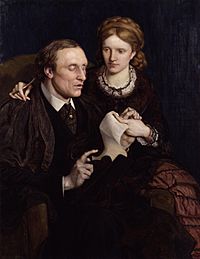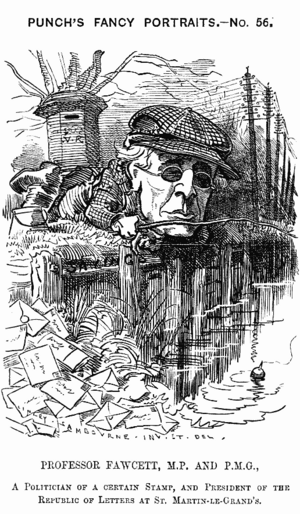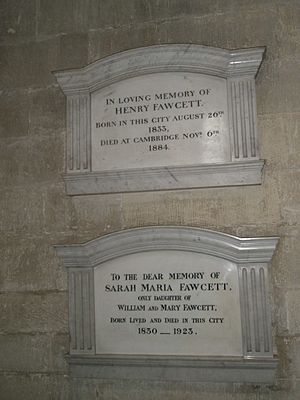Henry Fawcett facts for kids
Quick facts for kids
Henry Fawcett
|
|
|---|---|

Henry Fawcett and Millicent Garrett Fawcett by Ford Madox Brown, 1872, National Portrait Gallery, London.
|
|
| Postmaster General | |
| In office 3 May 1880 – 6 November 1884 |
|
| Monarch | Queen Victoria |
| Prime Minister | William Ewart Gladstone |
| Preceded by | Lord John Manners |
| Succeeded by | George Shaw-Lefevre |
| Personal details | |
| Born | 26 August 1833 Salisbury, England |
| Died | 6 November 1884 (aged 51) |
| Political party | Liberal |
| Spouses | Millicent Garrett (1847–1929) |
| Children | Philippa Fawcett |
| Alma mater | University of Cambridge |
Henry Fawcett (born August 26, 1833 – died November 6, 1884) was an important British person. He was a smart professor, a leader in government (a statesman), and an expert in economics.
Contents
Early Life and Education
Henry Fawcett was born in Salisbury, England. He went to King's College School and then to University of Cambridge. He studied at Peterhouse and Trinity Hall colleges. In 1856, he finished his degree and became a fellow at Trinity Hall.
In 1858, when he was 25, a terrible accident happened. He was shot and became blind. Even though he couldn't see, he kept studying. He focused a lot on economics. He even started training to be a lawyer, but he decided to follow a different path.
Becoming a Professor
In 1863, Henry Fawcett wrote a book called Manual of Political Economy. This book helped him become well-known. Later that year, he became a professor at Cambridge University. He taught about political economy, which is how countries manage their money and resources.
He wrote other important books too. These included The Economic Position of the British Labourer (1865) and Labour and Wages. These books showed his deep understanding of how people earned money and lived. In 1883, he was chosen to be the leader of Glasgow University.
Working in Politics
Henry Fawcett wanted to help people through government. He tried several times to become a Member of Parliament (MP). Finally, in 1865, he was elected as an MP for Brighton. He held this job until 1874. After that, he represented Hackney until 1884.
He strongly believed that women should have the right to vote. He worked hard to support women's suffrage, which was a very important cause at the time.
In 1880, a famous leader named William Ewart Gladstone chose Henry Fawcett for a big job. He became the Postmaster General. This meant he was in charge of the Post Office.
Innovations at the Post Office
As Postmaster General, Henry Fawcett made many improvements. He wanted to help ordinary people save money. He encouraged saving through the Post Office Savings Bank. He even introduced "savings stamps." These stamps allowed people to save tiny amounts of money, like pennies, until they had enough to open a bank account.
He also made it possible for people to turn their Post Office savings into government investments. He improved the Post Office's life insurance and retirement plans. Henry Fawcett brought in many new ideas. These included parcel post (sending packages), postal orders (a way to send money), and changes that allowed payphones and long-distance phone lines.
Family Life
Henry Fawcett was a strong supporter of women's rights. Through his work for women's suffrage, he met Elizabeth Garrett Anderson. She was one of the first female doctors. He asked her to marry him in 1865, but she said no. She wanted to focus on her medical career.
In 1867, Henry Fawcett married Elizabeth's younger sister, Millicent Fawcett. Millicent also became a very famous leader for women's rights. They had one child, a daughter named Philippa Fawcett. Philippa grew up to be a brilliant mathematician.
Henry Fawcett's life ended too soon. He passed away in November 1884 from a lung illness called pleurisy. He was only 51 years old. He is buried in Trumpington Extension Cemetery in Cambridge.
Remembering Henry Fawcett
Many people remembered Henry Fawcett for his important work. There are statues of him in different places. One is in Salisbury Market Square, and another is in Victoria Embankment Gardens in London. This London statue was made by a famous artist named Mary Grant.
A memorial to him, made by the sculptor Alfred Gilbert, is located in Westminster Abbey. This is a very special place where many important British people are honored.
Two primary schools are named after him: Fawcett Primary School in Cambridge and Henry Fawcett primary school in London. When postal workers formed a union in London in 1890, they named it the Fawcett Association. This showed how much they respected him.






